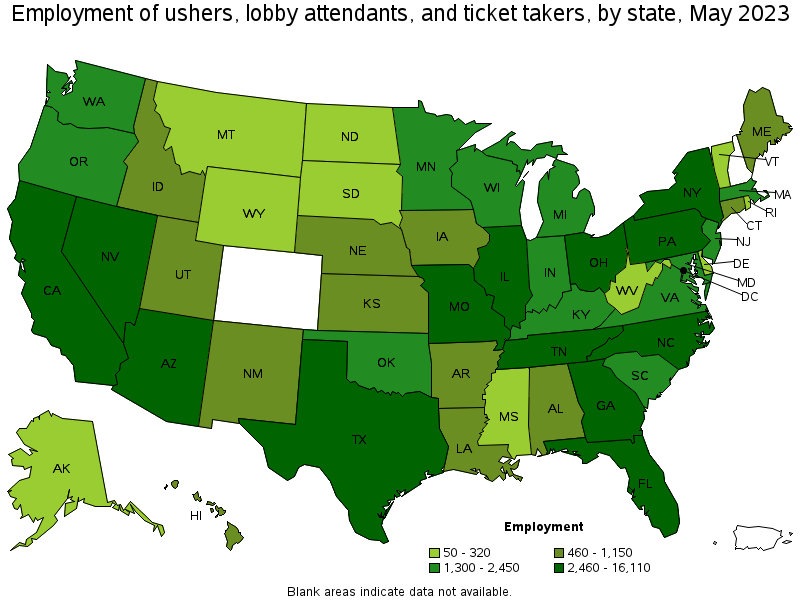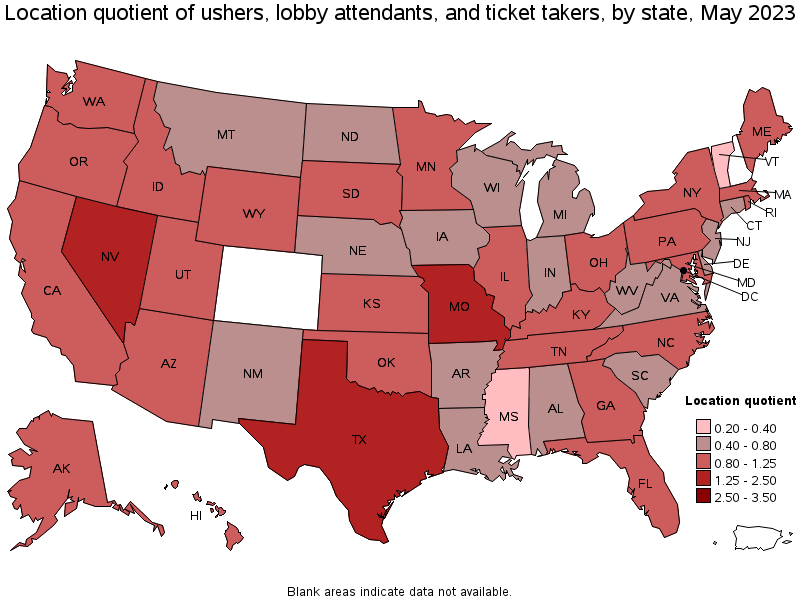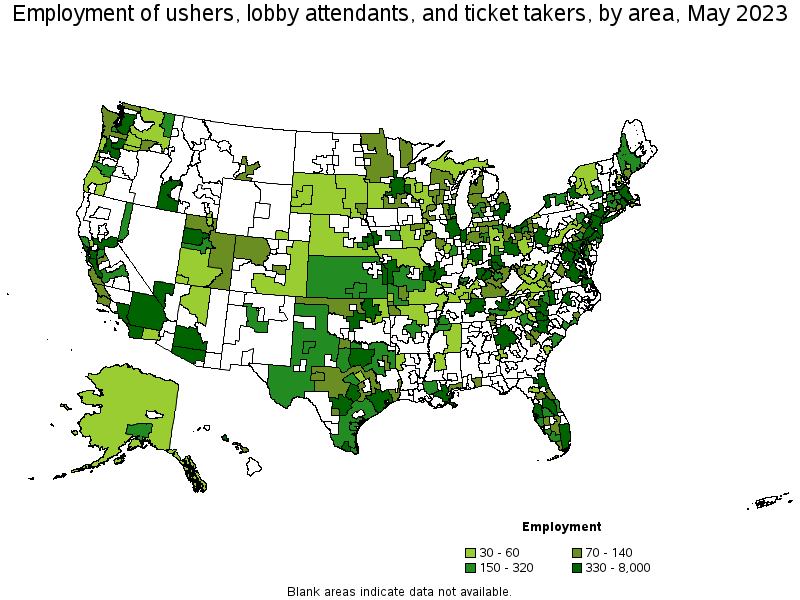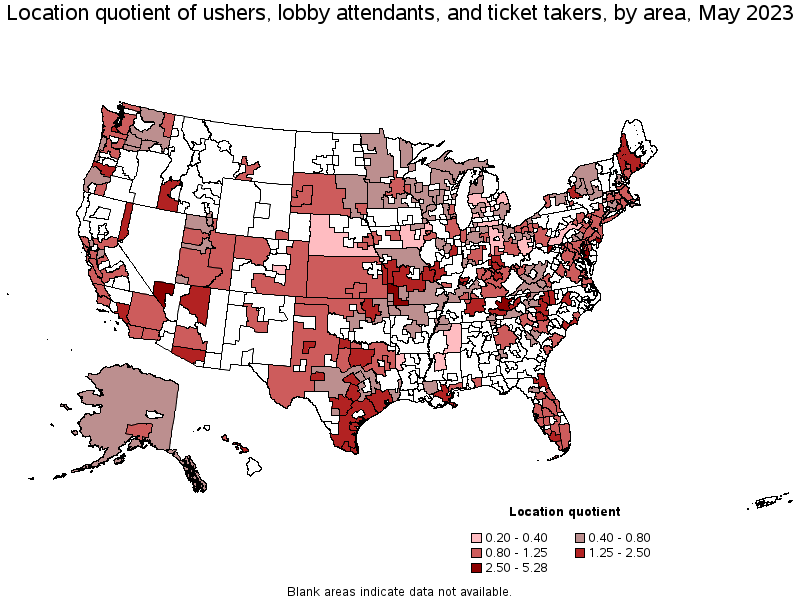An official website of the United States government
 United States Department of Labor
United States Department of Labor
Assist patrons at entertainment events by performing duties, such as collecting admission tickets and passes from patrons, assisting in finding seats, searching for lost articles, and helping patrons locate such facilities as restrooms and telephones.
Employment estimate and mean wage estimates for Ushers, Lobby Attendants, and Ticket Takers:
| Employment (1) | Employment RSE (3) |
Mean hourly wage |
Mean annual wage (2) |
Wage RSE (3) |
|---|---|---|---|---|
| 117,560 | 2.4 % | $ 14.67 | $ 30,520 | 0.6 % |
Percentile wage estimates for Ushers, Lobby Attendants, and Ticket Takers:
| Percentile | 10% | 25% | 50% (Median) |
75% | 90% |
|---|---|---|---|---|---|
| Hourly Wage | $ 10.45 | $ 12.10 | $ 14.32 | $ 16.73 | $ 18.16 |
| Annual Wage (2) | $ 21,730 | $ 25,170 | $ 29,780 | $ 34,800 | $ 37,780 |
Industries with the highest published employment and wages for Ushers, Lobby Attendants, and Ticket Takers are provided. For a list of all industries with employment in Ushers, Lobby Attendants, and Ticket Takers, see the Create Customized Tables function.
Industries with the highest levels of employment in Ushers, Lobby Attendants, and Ticket Takers:
| Industry | Employment (1) | Percent of industry employment | Hourly mean wage | Annual mean wage (2) |
|---|---|---|---|---|
| Motion Picture and Video Industries | 58,370 | 14.45 | $ 13.71 | $ 28,510 |
| Promoters of Performing Arts, Sports, and Similar Events | 18,260 | 11.16 | $ 15.80 | $ 32,870 |
| Spectator Sports | 6,110 | 4.06 | $ 13.67 | $ 28,420 |
| Performing Arts Companies | 5,560 | 4.12 | $ 16.22 | $ 33,730 |
| Employment Services | 5,000 | 0.13 | $ 14.82 | $ 30,820 |
Industries with the highest concentration of employment in Ushers, Lobby Attendants, and Ticket Takers:
| Industry | Employment (1) | Percent of industry employment | Hourly mean wage | Annual mean wage (2) |
|---|---|---|---|---|
| Motion Picture and Video Industries | 58,370 | 14.45 | $ 13.71 | $ 28,510 |
| Promoters of Performing Arts, Sports, and Similar Events | 18,260 | 11.16 | $ 15.80 | $ 32,870 |
| Performing Arts Companies | 5,560 | 4.12 | $ 16.22 | $ 33,730 |
| Spectator Sports | 6,110 | 4.06 | $ 13.67 | $ 28,420 |
| Museums, Historical Sites, and Similar Institutions | 1,810 | 1.07 | $ 15.75 | $ 32,760 |
Top paying industries for Ushers, Lobby Attendants, and Ticket Takers:
| Industry | Employment (1) | Percent of industry employment | Hourly mean wage | Annual mean wage (2) |
|---|---|---|---|---|
| Business, Professional, Labor, Political, and Similar Organizations | 600 | 0.14 | $ 22.12 | $ 46,000 |
| Civic and Social Organizations | 460 | 0.14 | $ 21.15 | $ 44,000 |
| Other Support Services | 740 | 0.23 | $ 19.56 | $ 40,690 |
| Management of Companies and Enterprises | 40 | (7) | $ 19.21 | $ 39,970 |
| Web Search Portals, Libraries, Archives, and Other Information Services | (8) | (8) | $ 18.11 | $ 37,670 |
States and areas with the highest published employment, location quotients, and wages for Ushers, Lobby Attendants, and Ticket Takers are provided. For a list of all areas with employment in Ushers, Lobby Attendants, and Ticket Takers, see the Create Customized Tables function.

States with the highest employment level in Ushers, Lobby Attendants, and Ticket Takers:
| State | Employment (1) | Employment per thousand jobs | Location quotient (9) | Hourly mean wage | Annual mean wage (2) |
|---|---|---|---|---|---|
| Texas | 16,110 | 1.19 | 1.53 | $ 12.90 | $ 26,830 |
| California | 15,440 | 0.86 | 1.11 | $ 17.54 | $ 36,470 |
| New York | 8,370 | 0.89 | 1.15 | $ 17.87 | $ 37,160 |
| Florida | 7,060 | 0.74 | 0.95 | $ 14.00 | $ 29,110 |
| Illinois | 4,810 | 0.80 | 1.03 | $ 15.14 | $ 31,490 |

States with the highest concentration of jobs and location quotients in Ushers, Lobby Attendants, and Ticket Takers:
| State | Employment (1) | Employment per thousand jobs | Location quotient (9) | Hourly mean wage | Annual mean wage (2) |
|---|---|---|---|---|---|
| Nevada | 2,460 | 1.66 | 2.14 | $ 14.66 | $ 30,490 |
| District of Columbia | 960 | 1.36 | 1.76 | $ 18.76 | $ 39,020 |
| Texas | 16,110 | 1.19 | 1.53 | $ 12.90 | $ 26,830 |
| Missouri | 3,290 | 1.14 | 1.48 | $ 14.48 | $ 30,110 |
| Maryland | 2,450 | 0.92 | 1.18 | $ 15.35 | $ 31,940 |

Top paying states for Ushers, Lobby Attendants, and Ticket Takers:
| State | Employment (1) | Employment per thousand jobs | Location quotient (9) | Hourly mean wage | Annual mean wage (2) |
|---|---|---|---|---|---|
| District of Columbia | 960 | 1.36 | 1.76 | $ 18.76 | $ 39,020 |
| New York | 8,370 | 0.89 | 1.15 | $ 17.87 | $ 37,160 |
| California | 15,440 | 0.86 | 1.11 | $ 17.54 | $ 36,470 |
| Washington | 2,450 | 0.70 | 0.91 | $ 17.45 | $ 36,290 |
| Colorado | (8) | (8) | (8) | $ 17.08 | $ 35,520 |

Metropolitan areas with the highest employment level in Ushers, Lobby Attendants, and Ticket Takers:
| Metropolitan area | Employment (1) | Employment per thousand jobs | Location quotient (9) | Hourly mean wage | Annual mean wage (2) |
|---|---|---|---|---|---|
| New York-Newark-Jersey City, NY-NJ-PA | 8,000 | 0.84 | 1.09 | $ 17.93 | $ 37,280 |
| Los Angeles-Long Beach-Anaheim, CA | 6,900 | 1.12 | 1.44 | $ 17.35 | $ 36,090 |
| Dallas-Fort Worth-Arlington, TX | 4,630 | 1.17 | 1.51 | $ 13.14 | $ 27,330 |
| Chicago-Naperville-Elgin, IL-IN-WI | 3,960 | 0.88 | 1.13 | $ 15.32 | $ 31,870 |
| Houston-The Woodlands-Sugar Land, TX | 3,510 | 1.10 | 1.42 | $ 13.69 | $ 28,480 |
| Washington-Arlington-Alexandria, DC-VA-MD-WV | 2,670 | 0.86 | 1.11 | $ 16.95 | $ 35,260 |
| Philadelphia-Camden-Wilmington, PA-NJ-DE-MD | 2,580 | 0.91 | 1.18 | $ 13.75 | $ 28,590 |
| Atlanta-Sandy Springs-Roswell, GA | 2,470 | 0.88 | 1.13 | $ 13.94 | $ 28,980 |
| Las Vegas-Henderson-Paradise, NV | 2,130 | 1.96 | 2.54 | $ 14.69 | $ 30,550 |
| Phoenix-Mesa-Scottsdale, AZ | 2,050 | 0.90 | 1.16 | $ 15.93 | $ 33,140 |

Metropolitan areas with the highest concentration of jobs and location quotients in Ushers, Lobby Attendants, and Ticket Takers:
| Metropolitan area | Employment (1) | Employment per thousand jobs | Location quotient (9) | Hourly mean wage | Annual mean wage (2) |
|---|---|---|---|---|---|
| Knoxville, TN | 1,070 | 2.59 | 3.34 | $ 10.14 | $ 21,080 |
| Atlantic City-Hammonton, NJ | 290 | 2.28 | 2.95 | $ 16.40 | $ 34,100 |
| Las Vegas-Henderson-Paradise, NV | 2,130 | 1.96 | 2.54 | $ 14.69 | $ 30,550 |
| Champaign-Urbana, IL | 180 | 1.74 | 2.25 | $ 14.30 | $ 29,740 |
| McAllen-Edinburg-Mission, TX | 490 | 1.70 | 2.20 | $ 10.62 | $ 22,080 |
| Lubbock, TX | 250 | 1.69 | 2.18 | $ 12.69 | $ 26,400 |
| Austin-Round Rock, TX | 2,000 | 1.62 | 2.09 | $ 13.77 | $ 28,640 |
| Greensboro-High Point, NC | 540 | 1.52 | 1.96 | $ 12.39 | $ 25,760 |
| San Antonio-New Braunfels, TX | 1,650 | 1.51 | 1.95 | $ 12.44 | $ 25,870 |
| Olympia-Tumwater, WA | 180 | 1.47 | 1.90 | $ 16.69 | $ 34,710 |

Top paying metropolitan areas for Ushers, Lobby Attendants, and Ticket Takers:
| Metropolitan area | Employment (1) | Employment per thousand jobs | Location quotient (9) | Hourly mean wage | Annual mean wage (2) |
|---|---|---|---|---|---|
| El Centro, CA | 40 | 0.64 | 0.83 | $ 20.48 | $ 42,590 |
| San Francisco-Oakland-Hayward, CA | 1,930 | 0.80 | 1.03 | $ 19.91 | $ 41,400 |
| San Jose-Sunnyvale-Santa Clara, CA | 850 | 0.74 | 0.96 | $ 19.27 | $ 40,070 |
| Seattle-Tacoma-Bellevue, WA | 1,410 | 0.68 | 0.88 | $ 18.12 | $ 37,680 |
| New York-Newark-Jersey City, NY-NJ-PA | 8,000 | 0.84 | 1.09 | $ 17.93 | $ 37,280 |
| Kahului-Wailuku-Lahaina, HI | 100 | 1.38 | 1.79 | $ 17.70 | $ 36,820 |
| Napa, CA | 40 | 0.51 | 0.66 | $ 17.58 | $ 36,560 |
| Beaumont-Port Arthur, TX | 90 | 0.55 | 0.71 | $ 17.50 | $ 36,400 |
| Stockton-Lodi, CA | 170 | 0.59 | 0.77 | $ 17.37 | $ 36,120 |
| Los Angeles-Long Beach-Anaheim, CA | 6,900 | 1.12 | 1.44 | $ 17.35 | $ 36,090 |
Nonmetropolitan areas with the highest employment in Ushers, Lobby Attendants, and Ticket Takers:
| Nonmetropolitan area | Employment (1) | Employment per thousand jobs | Location quotient (9) | Hourly mean wage | Annual mean wage (2) |
|---|---|---|---|---|---|
| Southwest Missouri nonmetropolitan area | 300 | 4.09 | 5.28 | $ 13.15 | $ 27,350 |
| Kansas nonmetropolitan area | 290 | 0.74 | 0.95 | $ 10.16 | $ 21,120 |
| North Texas Region of Texas nonmetropolitan area | 220 | 0.78 | 1.01 | $ 11.04 | $ 22,960 |
| Southwest Maine nonmetropolitan area | 210 | 1.12 | 1.45 | $ 15.16 | $ 31,530 |
| East Tennessee nonmetropolitan area | 190 | 1.34 | 1.73 | $ 14.15 | $ 29,430 |
Nonmetropolitan areas with the highest concentration of jobs and location quotients in Ushers, Lobby Attendants, and Ticket Takers:
| Nonmetropolitan area | Employment (1) | Employment per thousand jobs | Location quotient (9) | Hourly mean wage | Annual mean wage (2) |
|---|---|---|---|---|---|
| Southwest Missouri nonmetropolitan area | 300 | 4.09 | 5.28 | $ 13.15 | $ 27,350 |
| Maryland nonmetropolitan area | 150 | 2.59 | 3.35 | $ 14.10 | $ 29,320 |
| East Tennessee nonmetropolitan area | 190 | 1.34 | 1.73 | $ 14.15 | $ 29,430 |
| Southwest Maine nonmetropolitan area | 210 | 1.12 | 1.45 | $ 15.16 | $ 31,530 |
| Coastal Plains Region of Texas nonmetropolitan area | 160 | 1.10 | 1.42 | $ 11.46 | $ 23,840 |
Top paying nonmetropolitan areas for Ushers, Lobby Attendants, and Ticket Takers:
| Nonmetropolitan area | Employment (1) | Employment per thousand jobs | Location quotient (9) | Hourly mean wage | Annual mean wage (2) |
|---|---|---|---|---|---|
| Southwest Montana nonmetropolitan area | (8) | (8) | (8) | $ 17.29 | $ 35,960 |
| Eastern Washington nonmetropolitan area | 60 | 0.60 | 0.77 | $ 17.08 | $ 35,520 |
| Massachusetts nonmetropolitan area | 30 | 0.51 | 0.66 | $ 16.85 | $ 35,050 |
| Western Washington nonmetropolitan area | 100 | 0.76 | 0.98 | $ 16.61 | $ 34,560 |
| Northwest Colorado nonmetropolitan area | 100 | 0.80 | 1.04 | $ 16.59 | $ 34,510 |
These estimates are calculated with data collected from employers in all industry sectors, all metropolitan and nonmetropolitan areas, and all states and the District of Columbia. The top employment and wage figures are provided above. The complete list is available in the downloadable XLS files.
The percentile wage estimate is the value of a wage below which a certain percent of workers fall. The median wage is the 50th percentile wage estimate—50 percent of workers earn less than the median and 50 percent of workers earn more than the median. More about percentile wages.
(1) Estimates for detailed occupations do not sum to the totals because the totals include occupations not shown separately. Estimates do not include self-employed workers.
(2) Annual wages have been calculated by multiplying the hourly mean wage by a "year-round, full-time" hours figure of 2,080 hours; for those occupations where there is not an hourly wage published, the annual wage has been directly calculated from the reported survey data.
(3) The relative standard error (RSE) is a measure of the reliability of a survey statistic. The smaller the relative standard error, the more precise the estimate.
(7) The value is less than .005 percent of industry employment.
(8) Estimate not released.
(9) The location quotient is the ratio of the area concentration of occupational employment to the national average concentration. A location quotient greater than one indicates the occupation has a higher share of employment than average, and a location quotient less than one indicates the occupation is less prevalent in the area than average.
Other OEWS estimates and related information:
May 2023 National Occupational Employment and Wage Estimates
May 2023 State Occupational Employment and Wage Estimates
May 2023 Metropolitan and Nonmetropolitan Area Occupational Employment and Wage Estimates
May 2023 National Industry-Specific Occupational Employment and Wage Estimates
Last Modified Date: April 3, 2024